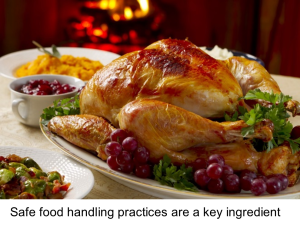
By Elizabeth Andress, UGA Extension Food Safety Specialist
A family to cook for, a big bird to roast, and too many cooks in the kitchen can lead to food-borne illness from holiday dining. But handling and cooking a turkey shouldn’t be an illness waiting to happen. Following basic recommendations will help ensure safe food and prevent food-borne illness for diners–not only during the holidays, but year-round.
First be sure to keep everything clean! Wash hands and kitchen surfaces often with hot soapy water, and wash cutting boards, dishes, and utensils after preparing each food item – before working with another food item. Use paper towels to clean up countertops and sanitize food surfaces after washing and rinsing, especially if raw turkey, meat or vegetables have been in contact with them. Mix 1 teaspoon of unscented household chlorine bleach per quart of cool, clean water to make an effective sanitizer. Apply to surfaces and allow them to air dry while you wash the sanitizer from your hands.
Next, keep things separated. Use one cutting board for raw meat, poultry, and seafood and a different, clean cutting board for ready-to-eat foods. Never place cooked food on a plate that previously held raw meat and poultry unless the plate has been thoroughly cleaned in between uses. Cook food to the proper temperature. Here are the current recommendations for roasting a turkey. Set the oven temperature to 325°F or higher. Place the turkey on a rack in a roasting pan and into the center of the oven. Whole poultry is safe when cooked to a minimum internal temperature of 165°F as measured with a food thermometer. Check the internal temperature in the innermost part of the thigh and wing and the thickest part of the breast. To avoid pink meat and rubbery texture, cook the turkey to a higher internal temperature, such as 180°F.
Even if the turkey comes equipped with a “pop-up” temperature indicator, it’s important to use an accurate food thermometer to ensure its safety. After taking the turkey out of the oven, let it stand 20 minutes before carving for best quality.
Stuffing should be cooked separately from the turkey rather than inside it. For food safety, stuffing needs to reach an internal temperature of 165°F, but it takes much longer to get there if it’s inside the turkey. By the time the stuffing reaches 165°F, the turkey may be overcooked and dry. By cooking the stuffing and the turkey separately, you can better control the temperature that each one reaches.
Finally, chill everything promptly! Refrigerate or freeze leftovers within 2 hours by placing them in shallow containers to cool rapidly. Keep the refrigerator temperature at 40ºF or below and the freezer at 0ºF. Monitor the temperature with an appliance thermometer. Refrigerated foods should be stored at a food temperature of 40 ºF. Always thaw food in the refrigerator, in cold running water, or in the microwave and marinate foods in the refrigerator. For more information, see the USDA “Countdown to the Thanksgiving Holiday” webpage or call the USDA Meat and Poultry Hotline at 1-888-674-6854 to speak with a food safety specialist – in English or Spanish – year round from 10 a.m. to 6 p.m., and on Thanksgiving day from 8 a.m. to 2 p.m. You can also email questions to MPHotline.fsis@usda.gov .
Approximate cooking times for fully thawed turkeys*
| Turkey weight | Unstuffed cooking time | Stuffed cooking time |
| 8-12 pounds | 2.75-3 hours | 3-3.5 hours |
| 12-14 pounds | 3-3.75 hours | 3.5-4 hours |
| 14-18 pounds | 3.75-4.25 hours | 4-4.5 hours |
| 18-20 pounds | 4.25-4.5 hours | 4.25-4.75 hours |
| 20-24 pounds | 4.5-5 hours | 4.75-5.25 hours |
*These times are approximations for turkeys that are fully thawed and held in a refrigerator that is at or below 40°F. Always use a calibrated food thermometer to determine the doneness of the turkey; do not just go by time in the oven.